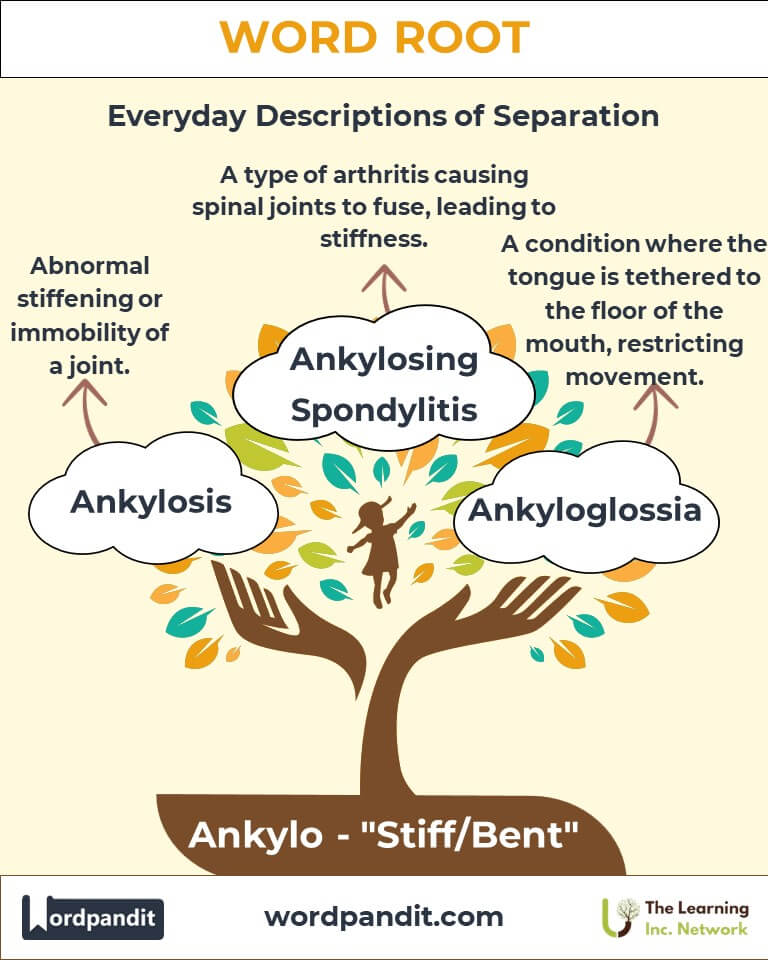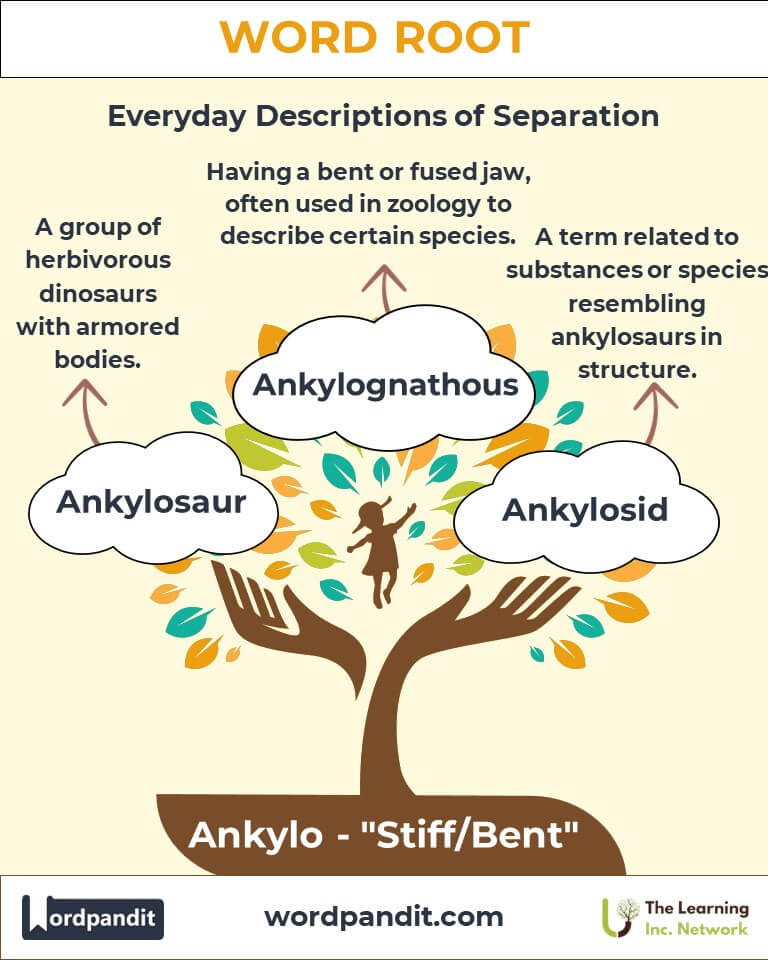Ankylo: The Rigid Root in Medicine and Beyond
Byline: Explore the origins, meanings, and applications of the Ankylo root, from its role in describing rigidity in anatomy to its metaphorical use in everyday language. Discover how this root has shaped our understanding of stiffness and immobility, both literally and figuratively.

Table of Contents
- Introduction: Understanding the Rigidity of "Ankylo"
- Etymology and Historical Journey
- Mnemonic: Unlocking the Power of "Ankylo"
- Common "Ankylo"-Related Terms
- "Ankylo" Through Time
- "Ankylo" in Specialized Fields
- Illustrative Story: "Ankylo" in Action
- Cultural Significance of the "Ankylo" Root
- The "Ankylo" Family Tree
- FAQs About the "Ankylo" Word Root
- Test Your Knowledge: "Ankylo" Mastery Quiz
- Conclusion: The Living Legacy of "Ankylo"
1. Introduction: Understanding the Rigidity of "Ankylo"
Have you ever wondered why some medical conditions involve stiffness or immobility? The word root "Ankylo" derives from the Greek word ankylos, meaning "crooked" or "stiff." Pronounced "ang-kai-loh," this root appears frequently in medical terminology to describe conditions of rigidity, fusion, or limited motion. From its applications in orthopedics to its metaphorical usage in language, "Ankylo" underscores the concept of stiffness and immobility, forming a foundation for understanding various physical and abstract constraints.

2. Etymology and Historical Journey
The term "Ankylo" traces back to the Greek ankylos, describing something bent, crooked, or stiff. Its earliest applications were likely anatomical, as ancient Greek and Roman physicians used it to describe deformities or fusions in joints. Over time, the term broadened to encompass any condition or state marked by rigidity. With the advent of modern medical science, "Ankylo" became embedded in the lexicon of pathology, describing conditions like ankylosis (joint fusion) and ankylosing spondylitis (a type of arthritis causing spinal fusion).
3. Mnemonic: Unlocking the Power of "Ankylo"
To remember "Ankylo," imagine a crooked or rusted hinge on a door that no longer opens smoothly. This visual of stiffness and immobility mirrors the essence of the word root.
Mnemonic Device: "Ankylo—The hinge of a door stuck in place, just as joints or ideas may become stiff or inflexible."
4. Common "Ankylo"-Related Terms
- Ankylosis (ang-kai-loh-sis): A condition where joints fuse and lose mobility.
Example: "The ankylosis in her fingers made simple tasks challenging." - Ankylosing Spondylitis (ang-kai-loh-sing spawn-dih-lie-tis): A chronic inflammatory disease causing spinal and sacroiliac joint fusion.
Example: "Ankylosing spondylitis is often managed with physical therapy and medication." - Ankylodactyly (ang-kai-loh-dak-tuh-lee): Fusion or stiffness in the fingers or toes.
Example: "Ankylodactyly can significantly limit hand function." - Ankylocheilia (ang-kai-loh-kai-lee-uh): Adhesion or stiffness of the lips.
Example: "The rare condition of ankylocheilia requires specialized surgical treatment." - Ankylophoria (ang-kai-loh-foh-ree-uh): A term used to describe a state of rigidity or inflexibility in behavior or thought.
Example: "His ankylophoria hindered his ability to adapt to new ideas."
5. "Ankylo" Through Time
- Ankylosis: Originally described as joint fusion due to injury or disease.
Modern Insight: Now includes the fusion resulting from autoimmune disorders like rheumatoid arthritis. - Ankylosing Spondylitis: Once classified as a form of arthritis, it is now recognized as a distinct autoimmune disease with genetic markers like HLA-B27.
6. "Ankylo" in Specialized Fields
- Medicine: Conditions like ankylosis and ankylosing spondylitis are pivotal in rheumatology and orthopedics.
Example: Treating ankylosis involves both pharmacological and surgical interventions. - Biology: Stiffness or fusion can be observed in animal anatomy, affecting mobility and survival.
- Metaphorical Usage: "Ankylo" is used to describe rigidity in thoughts or systems, emphasizing inflexibility.
7. Illustrative Story: "Ankylo" in Action
Dr. Elena, an experienced rheumatologist, was faced with a young patient who experienced severe back pain and stiffness. After careful examination and imaging, she diagnosed ankylosing spondylitis. Understanding the debilitating nature of the condition, she devised a treatment plan involving anti-inflammatory medication and physical therapy. Over time, the patient not only regained mobility but also became an advocate, raising awareness about the condition and inspiring others to seek timely intervention.
8. Cultural Significance of the "Ankylo" Root
The concept of rigidity, embodied in "Ankylo," resonates in cultural and metaphorical contexts. Philosophers often use stiffness to critique inflexibility in thought, and ancient texts describe both physical and metaphorical rigidity as obstacles to growth. This dual application of "Ankylo" demonstrates its enduring relevance.

9. The "Ankylo" Family Tree
- Kypho-: Relating to curvature or hump.
Example: Kyphosis – Abnormal curvature of the spine. - Arthro-: Referring to joints.
Example: Arthroscopy – A procedure to examine or treat joint conditions. - Osteo-: Pertaining to bones.
Example: Osteoporosis – A condition of bone weakening and brittleness.

FAQs About the "Ankylo" Word Root
Q: What does "Ankylo" signify in medical terms?
A: "Ankylo" refers to rigidity, stiffness, or fusion of anatomical structures, most commonly joints. It denotes a lack of mobility often caused by injury, inflammation, or diseases like arthritis.
Q: What is ankylosis, and how is it treated?
A: Ankylosis is the abnormal fusion of bones within a joint, leading to stiffness or immobility. Treatment includes physical therapy, anti-inflammatory medications, and sometimes surgery to restore mobility.
Q: What causes ankylosing spondylitis?
A: Ankylosing spondylitis is an autoimmune condition where the immune system mistakenly attacks the spine and sacroiliac joints, causing inflammation and eventual fusion. It’s associated with the genetic marker HLA-B27.
Q: Can "Ankylo" be used metaphorically?
A: Yes, "Ankylo" can describe rigidity beyond the physical realm. For instance, "ankylophoria" refers to inflexibility in thought or behavior, illustrating how this root applies metaphorically to mental or systemic stiffness.
Q: How does ankylosis impact daily life?
A: Ankylosis can make simple activities like walking, writing, or gripping objects challenging, depending on the affected joint. Early intervention and therapy can help manage its impact.
Test Your Knowledge: "Ankylo" Mastery Quiz
1. What does "Ankylo" primarily signify?
2. What does ankylodactyly refer to?
3. Which disease is characterized by spinal fusion?
4. Can "Ankylo" have non-medical meanings?
5. What is the root language of "Ankylo"?

12. Conclusion: The Living Legacy of "Ankylo"
"Ankylo" bridges the gap between physical and abstract realms, symbolizing rigidity in both anatomy and ideology. Its medical significance continues to evolve, offering insights into conditions like ankylosing spondylitis. The metaphorical use of "Ankylo" reminds us to remain flexible in thought, even as science uses its rigidity to understand the human body. As research advances, the enduring legacy of "Ankylo" will inspire both linguistic and scientific exploration.











